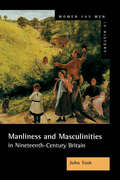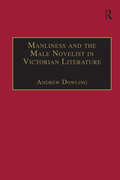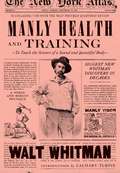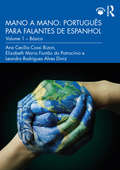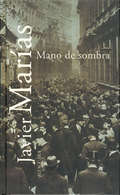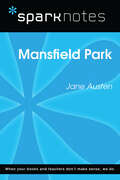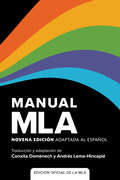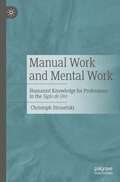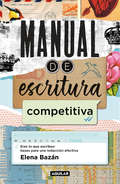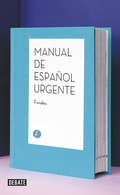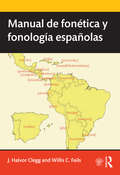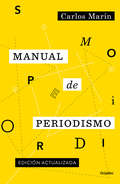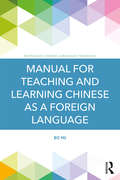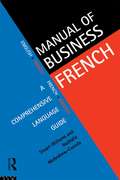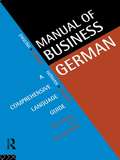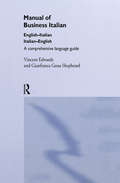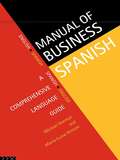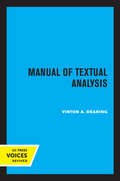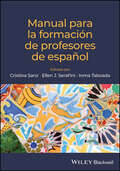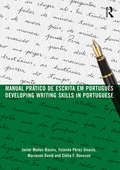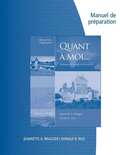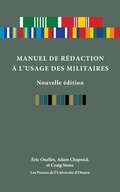- Table View
- List View
Manliness and Masculinities in Nineteenth-Century Britain: Essays on Gender, Family and Empire
by John ToshIn the space of barely fifteen years, the history of masculinity has become an important dimension of social and cultural history. John Tosh has been in the forefront of the field since the beginning, having written A Man’s Place: Masculinity and the Middle-Class Home in Victorian England (1999), and co-edited Manful Assertions: Masculinities in Britainsince 1800 (1991). Here he brings together nine key articles which he has written over the past ten years. These pieces document the aspirations of the first contributors to the field, and the development of an agenda of key historical issues which have become central to our conceptualising of gender in history. Later essays take up the issue of periodisation and the relationship of masculinity to other historical identities and structures, particularly in the context of the family. The last two essays, published for the first time, approach British imperial history in a fresh way. They argue that the empire needs to be seen as a specifically male enterprise, answering to masculine aspirations and insecurities. This leads to illuminating insights into the nature of colonial emigration and the popular investment in empire during the era the New Imperialism.
Manliness and the Male Novelist in Victorian Literature (The Nineteenth Century Series)
by Andrew DowlingThe purpose of this book is to address two principal questions: 'Was the concept of masculinity a topic of debate for the Victorians?' and 'Why is Victorian literature full of images of male deviance when Victorian masculinity is defined by discipline?' In his introduction, Dowling defines Victorian masculinity in terms of discipline. He then addresses the central question of why an official ideal of manly discipline in the nineteenth century co-existed with a literature that is full of images of male deviance. In answering this question, he develops a notion of 'hegemonic deviance', whereby a dominant ideal of masculinity defines itself by what it is not. Dowling goes on to examine the fear of effeminacy facing Victorian literary men and the strategies used to combat these fears by the nineteenth-century male novelist. In later chapters, concentrating on Dickens and Thackeray, he examines how the male novelist is defined against multiple images of unmanliness. These chapters illustrate the investment made by men in constructing male 'others', those sources of difference that are constantly produced and then crushed from within gender divide. By analysing how Victorian literary texts both reveal and reconcile historical anxieties about the meaning of manliness, Dowling argues that masculinity is a complex construction rather than a natural given.
Manly Health and Training: To Teach the Science of a Sound and Beautiful Body
by Walt Whitman Zachary TurpinA truly significant discovery, Walt Whitman’s Manly Health and Training is an entertaining health manifesto that sheds new light on one of America’s major nineteenth-century authors. In the fall of 1858, a thirteen-part essay series appeared in the New York Atlas, under the title Manly Health and Training. This nearly 47,000-word journalistic effort, written by Walt Whitman under his pen name “Mose Velsor,” was lost for more than 150 years, buried in just a handful of library archives, until its recent unexpected discovery. What you hold in your hands is a long-lost health manifesto that, remarkably, is as relevant today as it was back in the nineteenth century. A truly illuminating discovery that reveals much about a little-known period in Whitman’s life, this men’s guide features earnest recommendations for eating, sleeping, and exercise, emphasizing moderation and focusing on the holistic relationship between the mind and the body: —Be a carnivore: “Let the main part of the diet be meat, to the exclusion of all else.” —Engage in vigorous exercise: “Habituate yourself to the brisk walk in the fresh air—to the exercise of pulling the oar—and to the loud declamation upon the hills, or along the shore.” —Go to bed by 10 p.m.: “. . . with a plentiful supply of good air, during the six, seven, or eight hours that are spent in sleep. During most of the year, the window must be kept partly open for this purpose.” —Take a cold shower in the morning: “In most cases the best thing he can commence the day with is a rapid wash of the whole body in cold water, using a sponge, or the hands.” —Wear comfortable shoes: “Most of the usual fashionable boots and shoes, which neither favor comfort, nor health, nor the ease of walking, are to be discarded.” —Grow a beard: “The beard is a great sanitary protection to the throat—for purposes of health it should always be worn, just as much as the hair of the head should be.” —Banish depression: “If the victim of ‘the horrors’ could but pluck up energy enough to strip off all his clothes and gives his whole body a stinging rubdown with a flesh-brush till the skin becomes all red and aglow, he would be thoroughly cured of his depression, by this alone.” Filled with Whitmanic aphorisms and beautifully illustrated with contemporary artwork, Manly Health and Training provides essential insight into one of the world’s most beloved poets and his philosophy on manhood, bodily perfectibility, and the future of the American body politic.
Mannerist Fiction
by William DonoghueIn Mannerist Fiction, William Donoghue re-conceptualizes the history of formalism in western literature. Rather than presuming that literary experimentation with form - distorting space and time - began in the twentieth century with Modernism, Donoghue identifies the age of Copernicus as the crucible for the first experiments in spatial de-formation, which appeared in mannerist painting and literature. With wide-ranging erudition, Mannerist Fiction connects these literary and pictorial developments and traces their repetition and evolution over the next five hundred years.Time and again, Donoghue explains, scientific and literary paradigm shifts have occurred in parallel. Rabelais and Jonson wrote in the aftermath of changes in the western sense of space wrought by Copernicus and the voyages of discovery, Jonathan Swift and the Marquis de Sade in the age of Newton, Thomas Pynchon in the age of Einstein. With his analysis, Donoghue establishes disfigurement and deformation as perennial sources of literary fascination.
Mano a Mano: Volume 1 – Básico (Mano a mano: português para falantes de espanhol)
by Ana Cecília Cossi Bizon Elizabeth Maria Fontão do Patrocínio Leandro Rodrigues Alves DinizMano a Mano: Português para Falantes de Espanhol vem preencher uma importante lacuna no mercado editorial: a carência de livros didáticos que, considerando as necessidades específicas de falantes de espanhol, favoreçam um desenvolvimento mais rápido de sua proficiência em português. A coleção reúne uma série de características favoráveis à aprendizagem do português em diferentes contextos (ensino médio, universidades, cursos livres): Convida o(a) aluno(a) a desenvolver sua proficiência em português ao mesmo tempo que forma uma imagem multifacetada do Brasil, em diálogo com suas próprias construções culturais, desconstruindo discursos estabilizados e ampliando seus horizontes; Favorece o trânsito por múltiplas práticas de letramento, em que circulam diferentes gêneros discursivos, oferecendo oportunidades para que o(a) estudante aprimore suas capacidades de linguagem em contextos reais, ou próximos a situações autênticas de interação; Sensibiliza o(a) aluno(a) para diferentes variedades da língua portuguesa; Permite ao(à) estudante desenvolver suas capacidades léxico-gramaticais e fonético-fonológicas de maneira reflexiva e contextualizada, levando em consideração necessidades específicas de falantes de espanhol; Propõe tarefas semelhantes às encontradas no Certificado de Proficiência em Língua Portuguesa para Estrangeiros (Celpe-Bras), do Ministério da Educação brasileiro; É acompanhado por dois cadernos complementares integrados, com explicações detalhadas referentes a recursos léxico-gramaticais e fonético-fonológicos, além de uma série de atividades; Disponibiliza online os vídeos e áudios de tarefas de compreensão oral e de atividades de pronúncia. Preparado para o desenvolvimento de um curso de até 60 horas em contexto de imersão, ou 90 horas de não-imersão, Mano a Mano, Volume 1 – Básico permite levar falantes de espanhol (como língua materna ou estrangeira/adicional) que nunca tiveram contato significativo prévio com o português até o início do nível Intermediário do Celpe-Bras, do B1 do Quadro Europeu Comum de Referência para as Línguas, ou do Intermediário Médio do American Council on the Teaching of Foreign Languages.
Mano a Mano: Volume 2 – Intermediário (Mano a mano: português para falantes de espanhol)
by Ana Cecília Cossi Bizon Elizabeth Maria Fontão do Patrocínio Leandro Rodrigues Alves DinizMano a Mano: Português para Falantes de Espanhol vem preencher uma importante lacuna no mercado editorial: a carência de livros didáticos que, considerando as necessidades específicas de falantes de espanhol, favoreçam um desenvolvimento mais rápido de sua proficiência em português. A coleção reúne uma série de características favoráveis à aprendizagem do português em diferentes contextos (ensino médio, universidades, cursos livres): Convida o(a) aluno(a) a desenvolver sua proficiência em português ao mesmo tempo em que forma uma imagem multifacetada do Brasil, em diálogo com suas próprias construções culturais, desconstruindo discursos estabilizados e ampliando seus horizontes; Favorece o trânsito por múltiplas práticas de letramento, em que circulam diferentes gêneros discursivos, oferecendo oportunidades para que o(a) estudante aprimore suas capacidades de linguagem em contextos reais, ou próximos a situações autênticas de interação; Sensibiliza o(a) aluno(a) para diferentes variedades da língua portuguesa; Permite ao(à) estudante desenvolver suas capacidades léxico-gramaticais e fonético-fonológicas de maneira reflexiva e contextualizada, levando em consideração necessidades específicas de falantes de espanhol; Propõe tarefas semelhantes às encontradas no Certificado de Proficiência em Língua Portuguesa para Estrangeiros (Celpe-Bras), do Ministério da Educação brasileiro; É acompanhado por dois cadernos complementares integrados, com explicações detalhadas referentes a recursos léxico-gramaticais e fonético-fonológicos, além de uma série de atividades; Disponibiliza online os vídeos e áudios de tarefas de compreensão oral e de atividades de pronúncia. Preparado para o desenvolvimento de um curso de até 60 horas em contexto de imersão, ou 90 horas em contexto de não-imersão, Mano a Mano, Volume 2 – Intermediário permite levar falantes de espanhol (como língua materna ou estrangeira/adicional) do início do Intermediário Superior do Celpe-Bras, do início do B1 ao início do B2 do Quadro Europeu Comum de Referência para as Línguas, ou do início do Intermediário Médio ao início do Avançado Médio na escala do American Council on the Teaching of Foreign Languages.
Mano de sombra
by Javier Marías«Este volumen recoge dos años de tareas dominicales que prueban mi nula disposición a santificar las fiestas... Al releer estos ciento cuatro artículos seguidos, me parece que he opinado demasiado». Estas palabras sirven de introducción a un Javier Marías insólito, cotidiano, atento a lo que ocurre a su alrededor y que atraviesa todos los estados de ánimo imaginables: lo vemos evocativo e indignado, a menudo divertido y bromista pero también atribulado por la saña española que aún tiñe nuestro tiempo; melancólico, risueño, grave, irónico, compasivo o desengañado, siempre logra contagiarnos y no nos deja indiferentes con su Mano de sombra. Javier Marías es novelista hasta cuando opina, y cree que para decir tan solo lo que ya piensa la época por nosotros, lo consabido, más vale callarse. Así, sus artículos no exponen nunca lo previsible porque, a diferencia de tantos otros escritores, él piensa como si contara, y permiteque asistamos al discurrir de ese pensamiento con tanta intriga y zozobra como se asiste al desenvolvimiento de una historia.
Mansfield Park (SparkNotes Literature Guide Series)
by SparkNotesMansfield Park (SparkNotes Literature Guide) by Jane Austen Making the reading experience fun! Created by Harvard students for students everywhere, SparkNotes is a new breed of study guide: smarter, better, faster. Geared to what today's students need to know, SparkNotes provides: *Chapter-by-chapter analysis *Explanations of key themes, motifs, and symbols *A review quiz and essay topicsLively and accessible, these guides are perfect for late-night studying and writing papers
Manual MLA (EDICIÓN OFICIAL): Novena edición adaptada al español
by Andrés Lema-Hincapié Conxita DomènechGeneración tras generación, los escritores han confiado en el MLA Handbook, publicado por la Modern Language Association, como guía para redactar textos académicos y documentar fuentes. Esta nueva adaptación al español es una herramienta integral para escritores de trabajos de investigación en español o para cualquier escritor que necesite citar fuentes --estudiantes, docentes y bibliotecarios, pero también profesionales que redactan textos técnicos o de negocios--. El manual ofrece pautas uniformes y comprensibles para elaborar una prosa clara y atractiva, evaluar fuentes para citarlas y acreditarlas con precisión y dar formato a trabajos de investigación. Incluye información relevante sobregramática, puntuación, mayúsculas, ortografía y númeroscómo crear citas parentéticas dentro del texto, hacer un listado de obras citadas, crear notas al pie y notas finalescómo citar, parafrasear y resumircómo evitar el plagioEsta edición incluye indicaciones específicas para dominar el español escrito sobre temas como el uso de comas de enumeración, guiones o rayas; el uso de mayúsculas en títulos y subtítulos; la forma de presentar los apellidos; o la colocación de otros signos de puntuación en relación con las comillas. El Manual MLA ofrece cientos de ejemplos en español: citas de libros, artículos de revistas, sitios web, películas y programas de televisión, entre otros tipos de obras.Generations of writers have relied on the MLA Handbook, published by the Modern Language Association, for guidance on writing and on documenting sources. This new Spanish adaptation of the handbook is a comprehensive resource for Spanish-language writers of research papers and anyone citing sources, from business writers, technical writers, and editors to student writers and the teachers and librarians working with them. It establishes uniform, easy-to-follow guidelines that help writers craft clear and engaging prose, evaluate sources and accurately cite and credit them, and format research papers. It includes information ongrammar, punctuation, capitalization, spelling, and numberscreating in-text citations, the list of works cited, and footnotes and endnotesquoting, paraphrasing, and summarizingavoiding plagiarismGuidance unique to this edition includes matters of punctuation in Spanish, from the serial comma to hyphens and dashes; capitalizing titles and subtitles in Spanish and styling Spanish surnames; the placement of other punctuation marks in relation to quotation marks; and more. In the Manual MLA, readers will find hundreds of new Spanish-language examples--including citations for books, journal articles, websites, films, and television shows.
Manual Work and Mental Work: Humanist Knowledge for Professions in the Siglo de Oro
by Christoph StrosetzkiInformation Text: In the early modern period, numerous texts deal with professions by presenting the knowledge required in each case, individual fields of activity, purpose, origin and prestige. The course of argumentation is humanistic, insofar as it mostly starts from the human being. The ancient idea of the primacy of mental work over manual work is formative here. The importance of Spain results from the fact that the Spanish king Charles V was both emperor and ruler of the colonies in America, i.e. he ruled a world empire by the standards of the time. After discussing some central categories, overall representations of knowledge, professions, and prominent professional representatives are presented. Here, the hierarchization and its relativization by satire is revealing. The mechanical arts and the artes liberales are then presented on the basis of individual professions selected as characteristic examples, each with its own specific knowledge. The higher faculties of medicine, theology and jurisprudence with their representatives form the conclusion.
Manual de escritura competitiva: Eres lo que escribes: bases para una redacción efectiva
by Elena BazánEn una época donde la escritura es la esencia laboral, académica y social, quien no redacte de forma correcta y adecuada no será competitivo, seguido, ni tomado en serio por quienes participan en sus mismas redes, grupos y entorno. En este mundo de vértigo y transformaciones en los ámbitos científicos, sociales, laborales, tecnológicos y culturales, cada vez hablamos menos de frente y más a través de la pantalla, por lo que escribir ¡significa todo! Escritura competitiva implica que tengas habilidades para la redacción, así como textos que destaquen entre los muchos que giran a tu alrededor. Cómo lograr que te sigan, que sobresalgas en la escuela, en la empresa, en las redes sociales; que te lean en la bandeja de entrada; que te consideren para la entrevista de trabajo; que se interesen por la postulación de tu financiamiento; que se distinga tu anuncio... Estar preparado para redactar un texto, por más breve que sea, puede ser la diferencia para que tu mensaje pase o no desapercibido, para que tú destaques por tus expresiones escritas o que al mundo le sean indiferentes tus mensajes. Con un lenguaje dinámico, divertido y muy claro, este libro te ofrece las claves para una redacción competitiva: estilo, léxico, corrección, ortografía; así como las estrategias para deshacerte de las dudas, para saber qué hacer cuando no logras expresar bien un mensaje; e insiste en la importancia de la lectura en relación con la escritura, entre otros temas. Mejorar tu redacción no es imposible, ¡es indispensable! Recuerda, eres lo que escribes, puedes seducir con tus palabras si escribes frases reveladoras y contundentes. Así que encuentra en estas páginas las sugerencias más puntuales, tips, reflexiones, consejos y alertas para hacer de tu escritura un sello personal de éxito y excelencia.
Manual de español urgente
by FundéuTodo usuario inteligente de la lengua tropieza permanentemente con dudas. El Manual de español urgente es una guía ágil y concisa para resolver todas esas cuestiones cotidianas que afean la lengua y dificultan la comunicación. ¿Cuál es el plural de «currículum»?¿El pasado de «prever» es «previó» o «preveyó»?¿Son admisibles palabras como «ecologizar», «empoderar» «experticida» o «señalética»?¿Hay alternativas para «baby shower», «fracking», «selfie» o «stock options»?¿Es apropiado usar abreviaturas en las redes sociales?¿Qué palabras se escriben en cursiva? El Manual de español urgente ha sido, desde su publicación en 1985, un referente para quienes tienen el español como instrumento de trabajo y buscan un sitio donde resolver sus dudas y encontrar propuestas que les ayuden a expresarse con precisión y eficacia. Esta nueva edición, actualizada y revisada, es el fruto del trabajo de la Fundéu BBVA en su análisis de los medios de comunicación, materializado en sus recomendaciones diarias, que buscan el equilibrio entre un español vivo y actual -atento al reto de las innovaciones tecnológicas- y la riqueza heredada de sus siglos de historia. No solo periodistas, sino también estudiantes, redactores de informes, responsables de redes sociales, blogueros, publicistas y, en general, cualquier persona que requiera una guía ágil y nada restrictiva para la claridad de su expresión oral o escrita encontrará en este manual una valiosa ayuda que le permitirá volcar sus opiniones, informaciones y reflexiones con precisión, ya sea en un medio tradicional o en internet.
Manual de fonética y fonología españolas
by J. Halvor Clegg Willis C. FailsWritten entirely in Spanish, Manual de fonética y fonología españolas has a comprehensive scope that touches on all aspects of phonetics and phonology—including acoustic and auditory phonetics, phonotactics, and suprasegmentals, which most often remain untreated. The book provides students with a detailed and accurate yet accessible introduction to Spanish phonetics and phonology. It includes introductory chapters which place these disciplines within the general field of linguistics and which emphasize the role of sounds and their representation in human communication. Key features: Written by trained phoneticians and informed by the current science of phonetics. No prior knowledge of linguistics assumed, as a foundation is laid throughout for all linguistic terms and concepts. Each chapter contains a summary, a list of concepts and terminology, review questions, and pedagogically relevant pronunciation exercises keyed to the specific hints and suggestions provided in the chapters. Chapters dealing with the physical production of sounds contain sections with “Pedagogical Hints,” “Practical Suggestions,” and “Pronunciation Exercises” to link theory to the practical aspects of improving pronunciation. A wealth of graphic material to illustrate each concept clearly. Models of how to pronounce the sounds, sentences and exercises presented in the text, are available online at routledge.com/cw/clegg. Manual de fonética y fonología españolas is a comprehensive introduction designed to be clear and accessible to advanced students of Spanish to help them understand how to improve their pronunciation. It will serve as an excellent book for graduate students as well as a valuable resource for teachers, linguists and language professionals.
Manual de periodismo: Edición actualizada
by Carlos Marín33 años después de su primera edición, el Manual de periodismo de Carlos Marín conserva plena vigencia en este tiempo, vertiginoso y extraordinario, para acercarse a lo que Gabriel García Márquez llamó «el mejor oficio del mundo». Si el piso más reciente del edificio periodístico se amuebla de manera constante con novedades y términos tecnológicos, los cimientos, profundos, poderosos, continúan siendo los de siempre: el conocimiento de los géneros, las fuentes de información, las técnicas de redacción, las exigencias éticas, la actitud ante los personajes de la noticia. Producto de la experiencia y la reflexión, este Manual está escrito con un lenguaje didáctico y numerosos ejemplos, con definiciones y señalamientos tan actuales y enfáticos como el hecho de que ningún periodista del siglo XXI puede evadirse de las nuevas tecnologías y las redes sociales sin detrimento de su trabajo, como tampoco puede dejar atrás las herramientas y enseñanzas del periodismo clásico.
Manual do escritor freelancer
by Susan PalmquistVocê já pensou na escrita freelance como uma maneira de ganhar um dinheiro extra, como uma carreira em período integral ou como um trampolim para escrever livros de não ficção? Nesse caso, junte-se a mim neste guia claro e simples que explicará, passo a passo, como fazer exatamente isso. Serão abordados os seguintes temas: Como montar o seu portfólio; Como obter seus primeiros recortes sem nenhuma experiência prévia; A importância de estudar o mercado e como fazê-lo da melhor forma possível; Tipos de escrita freelance; Formulação de ideias; Preparação do resumo perfeito; Trabalho com editores; O que fazer quando receber um trabalho; Entrevista com os melhores especialistas para o seu artigo; Como continuar recebendo trabalhos; Como gerenciar tempo e dinheiro.
Manual for Teaching and Learning Chinese as a Foreign Language (Routledge Chinese Language Pedagogy)
by Bo HuWritten in an extended dictionary format, the Manual for Teaching and Learning Chinese as a Foreign Language aims to cover all key terms related to teaching Chinese as a foreign language. Each section contains an introduction with language-specific information, and identifies students and teachers’ common questions, including the capacity of Chinese as a morphologically unmarked language to indicate categories such as tense and mood. Many entries listed in this manual come with an explanation, a commentary, and rich examples. The Manual for Teaching and Learning Chinese as a Foreign Language appeals to both Chinese as a foreign language (CFL) teachers and students, as well as being the ideal reference for researchers conducting comparative studies of the Chinese and English languages.
Manual of Business French (Manuals Of Business Ser.)
by Stuart Williams Nathalie McAndrew CazorlaManual of Business French is the most comprehensive, single-volume reference handbook for students and professionals using French. Designed for all users, no matter what level of language skill, this manual comprises five parts: * A 6000-word, two-way Glossary of the most useful business terms * A 100-page Written Communications section giving models of 50 letters, faxes and documents * An 80-page Spoken Situations section covering face-to-face and telephone situations * A short reference Grammar outlining the major grammar features of French * A short Business Facts section covering esential information of the country or countries where French is used Written by an experienced native and non-native speaker team, this unique volume is an essential, one-stop reference for all students and professionals studying or working in business and management where French is used.
Manual of Business German: A Comprehensive Language Guide (Manuals Of Business Ser.)
by Paul Hartley Gertrud RobinsManual of Business German is the most comprehensive, single-volume reference handbook for students and professionals using foreign languages.Designed for all users, no matter what level of language skill, it comprises five parts:* A 6000-word, two-way Glossary of the most useful business terms* A 100-page Written Communications section giving models of 50 letters, faxes and documents* An 80-page Spoken Situations section covering face-to-face and telephone situations* A short Reference Grammar outlining the major grammar features of German * A short Business Facts section covering essential information of the country or countries where German is usedWritten by an experienced native and non-native speaker team, this unique volume is an essential, one-stop reference for all students and professionals studying or working in business and management where German is used.
Manual of Business Italian: A Comprehensive Language Guide (Manuals Of Business Ser.)
by Vincent Edwards Gianfranca Gessa ShepheardManual of Business Italian is the most comprehensive, single-volume reference handbook for students and professionals using Italian.Designed for all users, no matter what level of language skill, this manual comprises five parts: * A 6000-word, two-way Glossary of the most useful business terms * A 100-page Written Communications section giving models of 50 letters, faxes and documents * An 80-page Spoken Situations section covering face-to-face and telephone situations * A short Reference Grammar outlining the major grammar features of Italian * A short Business Facts section covering essential information of the country or countries where Italian is used Written by an experienced native and non-native speaker team, this unique volume is an essential, one-stop reference for all students and professionals studying or working in business and management where Italian is used
Manual of Business Spanish: A Comprehensive Language Guide (Manuals Of Business Ser.)
by Michael Gorman Maria-Luisa HensonManual of Business Spanish is the most comprehensive, single-volume reference handbook for students and professionals using Spanish.Designed for all users, no matter what level of language skill, it comprises five parts:* A 6000-word, two-way Glossary of the most useful business terms* A 100-page Written Communications section giving models of 50 letters, faxes and documents* An 80-page Spoken Situations section covering face-to-face and telephone situations* A short Reference Grammar outlining the major grammar features of Spanish* A short Business Facts section covering essential information of the country or countries where Spanish is usedWritten by an experienced native and non-native speaker team, this unique volume is an essential, one-stop reference for all students and professionals studying or working in business and management where Spanish is used.
Manual of Textual Analysis
by Vinton A. DearingThis title is part of UC Press's Voices Revived program, which commemorates University of California Press’s mission to seek out and cultivate the brightest minds and give them voice, reach, and impact. Drawing on a backlist dating to 1893, Voices Revived makes high-quality, peer-reviewed scholarship accessible once again using print-on-demand technology. This title was originally published in 1959.
Manual para la formación de profesores de español
by Cristina Sanz Ellen J. Serafini Inma TaboadaA comprehensive, evidence-based pedagogical tool for Spanish teacher education An innovative resource written specifically for teacher education courses, Manual para la formación de profesores de español builds teachers’ knowledge of key constructs in second language learning, curriculum design, materials development, and evaluation. Written entirely in Spanish, this indispensable volume prepares students in advanced undergraduate courses and graduate degree or certificate programs for a career in teaching Spanish in second language (L2), heritage language (HL), and mixed L2/HL environments at the primary, secondary, and university level. Written by experienced educators specializing in both the cognitive and social dimensions of learning and teaching Spanish, the Manual contains real-world insights and evidence-based approaches to teaching language. Divided into two parts, the text first covers the fundamental concepts and approaches to second/heritage language learning and teaching before applying these concepts to the teaching of reading, listening, speaking, and writing and to assessment. Designed to be comprehensible for students who identify as native, heritage or second language speakers of Spanish, each chapter in Manual para la formación de profesores de español: Summarizes current knowledge on how additional languages are learned and discusses the most effective ways to teach them from a task-based perspective; Provides a sociohistorical perspective necessary to understand current research and state-of-the-art practices at the primary, secondary, and university level. Covers practical aspects of Spanish language teaching, such as the role of grammar and feedback, individual and group work, and materials preparation; Features useful tools that facilitate syllabus and class preparation, including summaries, keywords, further readings, discussion questions, and classroom-action research projects; Integrates comprehension, reflection, and application exercises to promote mastery of concepts for students of all levels Manual para la formación de profesores de español is an ideal text for both pre-service and in-service Spanish teachers in teacher training courses as well as those in teacher certification programs.
Manual prático de escrita em português: Developing Writing Skills in Portuguese (Developing Writing Skills)
by Javier Muñoz-Basols Marianne David Yolanda Pérez Sinusía Clélia F. DonovanManual prático de escrita em português/Developing Writing Skills in Portuguese provides intermediate- and advanced-level students with the necessary skills to become competent and confident writers in the Portuguese language. With a focus on writing as a craft, Manual prático de escrita em português offers a rich selection of original materials including narrative texts, expository essays, opinion pieces and newspaper articles. Each chapter covers a specific kind of writing and is designed to help tackle the material in small units. The book aids students in crafting clear, coherent and cohesive texts by means of guided practice and step-by-step activities. Suitable for use as a classroom text or as a self-study course, this book is ideal for students at level B2 – C2 of the Common European Framework for Languages or at Intermediate High – Advanced High on the ACTFL proficiency scales.
Manuel de Preparation for Bragger/Rice's Quant a Moi
by Jeannette D. Bragger Donald B. RiceHelping you maximize your study efforts and results, the MANUEL DE PRÉPARATION includes activities for review of previously learned material; preparation for grammar, speaking, and reading activities in the MANUEL DE CLASSE; activities to accompany the "Magazine Culture" sections of the text; vocabulary lists for each chapter theme; an answer key for self-correcting exercises, and the audio script.
Manuel de rédaction à l'usage des militaires, nouvelle édition
by Adam Chapnick Craig Stone Eric OuelletManuel de rédaction à l'usage des militaires est conçu pour aider le personnel militaire à rédiger des textes scientifiques dans un style clair et efficace. Fruit de la collaboration entre un professeur d’écriture chevronné et un officier militaire à la retraite, le manuel s’adresse aux membres des forces armées qui rejoignent le monde universitaire et qui ont déjà rédigé dans un contexte professionnel militaire ou qui n’ont aucune expérience de la rédaction. En plus d’enseigner aux officiers et officières comment rédiger efficacement, ce manuel explique en quoi la maîtrise des techniques de rédaction est utile au personnel des forces armées dans leurs tâches régulières, en particulier aux échelons supérieurs. L’ouvrage traite de l’importance de savoir communiquer par écrit, de ce qui distingue la rédaction savante de la rédaction professionnelle, des processus de recherche et de rédaction proprement dite, du professionnalisme dans la sphère universitaire ainsi que des problèmes et défis fréquemment rencontrés par les rédactrices et les rédacteurs. Un dernier chapitre novateur traite de la manière dont les officiers peuvent mettre à profit les connaissances qu’ils ont acquises par leurs expériences professionnelles dans le contexte universitaire. Des exemples concrets — à l’usage particulier des militaires — sont présentés tout au long du texte pour guider la lectrice et le lecteur de manière pratique et pertinente.Cette édition révisée comprend de nouveaux exemples provenant d’une plus grande variété de sources. Elle prend en compte l’évolution récente des technologies de communication et reflète les nouvelles avancées dans les domaines de l’enseignement et de l’apprentissage.Cet ouvrage, le seul guide exhaustif de rédaction à l’usage du personnel militaire, est un ajout incontournable à la bibliothèque de tout officier et officière militaire, où qu’il se trouve et quel que soit son rang.Ce livre est publié en français. Formats disponibles : couverture souple, PDF accessible et ePub accessible
